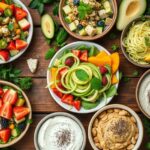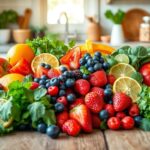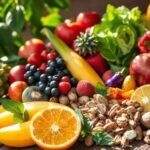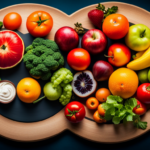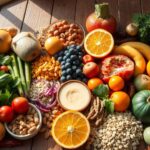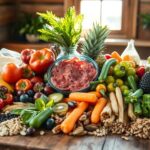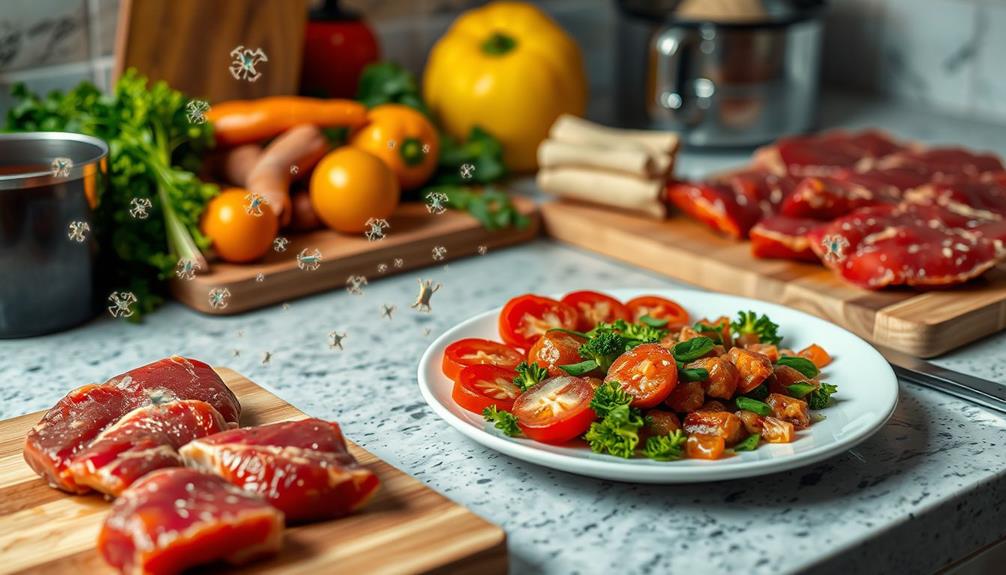Raw food veganism is all about eating unprocessed, plant-based foods that haven't been heated above 104-118°F. You'll focus on fresh fruits, veggies, nuts, seeds, and sprouted grains while avoiding all animal products and cooked items. This lifestyle is believed to help retain essential nutrients and enzymes that can boost health. Many enjoy benefits like weight loss and improved digestion. However, be aware of potential nutrient deficiencies. You'll often use creative methods like blending, juicing, and sprouting to prepare meals. If you're curious about how to get started, there's much more to explore on this journey!
Key Takeaways
- Raw food veganism focuses on unprocessed, plant-based foods not heated above 104-118°F, emphasizing fresh fruits, vegetables, nuts, and seeds.
- The diet is believed to enhance health by preserving essential enzymes and nutrients lost through cooking.
- Health benefits include reduced disease risk, weight loss, improved digestive health, and better overall health outcomes.
- Nutritional risks may involve deficiencies in vitamin B12, calcium, and protein, necessitating careful meal planning.
- Preparation techniques include blending, juicing, soaking, sprouting, and dehydrating to improve digestibility and flavor in raw dishes.
Definition of Raw Food Vegan
A raw food vegan diet is a lifestyle choice that focuses exclusively on unprocessed plant-based foods, which haven't been heated above 104-118°F (40-48°C). This means you avoid all animal products and cooked or processed items, opting instead for fresh fruits and vegetables, nuts, seeds, and sprouted grains. Following a raw food diet can provide numerous health benefits, including improved digestion, increased energy levels, and potential weight loss. Some proponents of the raw food diet also believe that cooking destroys enzymes in food that are essential for digestion and absorption of nutrients. However, it’s important to consult with a healthcare professional before making any drastic dietary changes, especially if you have any preexisting health conditions.
By following a raw vegan diet, you embrace the principles of raw foodism, believing that cooking destroys essential enzymes and nutrients crucial for ideal health. This diet is often rich in antioxidants, which are beneficial for overall health, and it encourages the consumption of foods that can aid in detoxification and cleansing purposes beneficial for overall health.
To adhere to this diet, you typically aim for at least 75% of your total food intake to be raw or minimally processed. Food preparation methods are fundamental here; you can blend, juice, soak, sprout, or dehydrate your ingredients.
These techniques not only preserve the raw quality of your meals but also offer a diverse range of textures and flavors.
Health Benefits of Raw Veganism
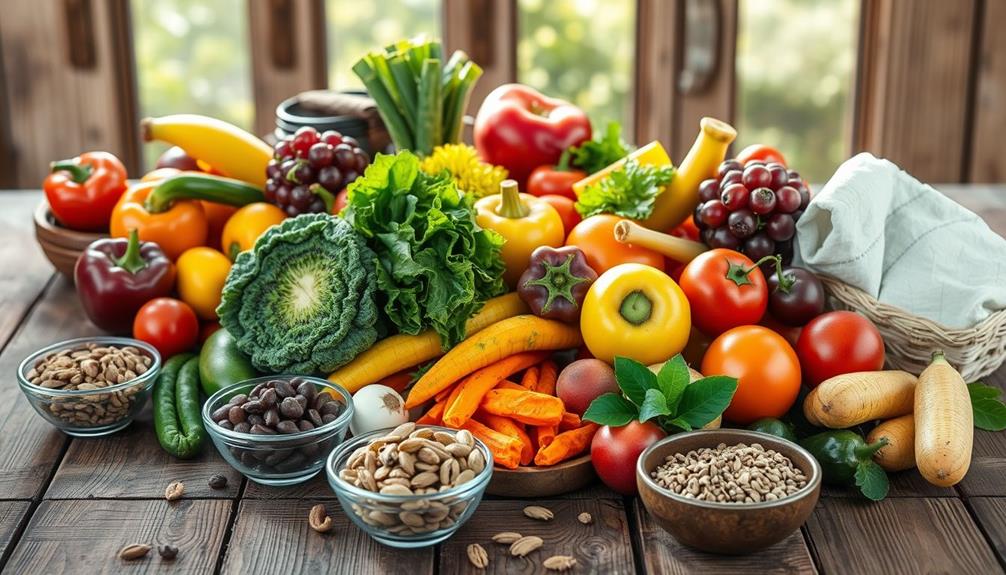
Embracing a raw vegan diet offers numerous health benefits that can greatly enhance your overall well-being. One of the most significant advantages is the reduced risk of heart disease, attributed to the high intake of fruits and vegetables that improve cardiovascular health. Studies show that following a raw vegan diet can lead to a 17% decrease in heart disease risk.
Additionally, this lifestyle promotes weight loss through low-calorie, high-fiber foods, making it easier to maintain a healthy weight.
Moreover, the high fiber content in raw foods supports digestive health and is linked to a 12% reduction in the risk of type 2 diabetes. If you're looking to manage your weight, this diet can also be effective—participants have reported weight loss ranging from 9.9 to 12 kg over 3.7 years.
Raw food benefits extend beyond weight management, as another significant benefit is the enhanced nutritional retention found in raw foods, which boosts the bioavailability of vitamins and minerals.
By consuming nutrient-dense foods, you promote gut health, which can lead to improved overall health outcomes and support beneficial gut bacteria.
Nutritional Risks and Considerations

While the raw vegan diet offers several health benefits, it's important to be aware of the nutritional risks and considerations that come with it. One major concern is the potential for deficiencies in essential nutrients like vitamin B12, calcium, and vitamin D. Without animal products or certain cooked foods, you may struggle to meet your nutritional needs.
Furthermore, a raw vegan diet often lacks adequate sources of iron and protein, which are significant for maintaining energy levels and muscle mass. Long-term adherence to a raw vegan diet can lead to low bone mass and an increased risk of fractures, making it imperative to monitor your calcium intake.
Consideration of natural remedies can also play a role in supporting overall health.
Additionally, the high fruit consumption often associated with this diet can lead to dental issues, with an alarming 97% of raw food dieters reporting tooth decay due to increased acidity.
Women on long-term raw vegan diets may also face irregular menstrual cycles, with about 30% experiencing hormonal disruptions linked to low caloric intake.
To mitigate these risks, proper meal planning is crucial. You'll need to guarantee a diverse intake of plant-based protein sources and iron-rich foods to prevent nutritional imbalances.
Food Preparation Techniques

When it comes to raw food preparation, you'll find techniques like blending and juicing essential for maximizing flavor and nutrition.
These methods can also be complemented by using essential oils for wellness to enhance the overall experience of your meals.
Soaking and sprouting nuts and seeds not only enhance their digestibility but also boost their nutritional value.
Plus, dehydrating foods can intensify flavors while keeping everything raw, making your meals more exciting.
Blending and Juicing Methods
Blending and juicing methods are vital techniques for anyone diving into the raw food vegan lifestyle.
These methods not only help you create delicious drinks but also guarantee you maximize the nutritional benefits of raw ingredients. For instance, the process of extracting juice can enhance the flavor profile of your beverages, similar to how different coffee varieties offer unique taste experiences.
Here's how you can make the most of blending and juicing:
- Blending: Combine fruits, vegetables, nuts, and seeds in high-speed blenders to craft nutrient-rich smoothies. This method retains vitamins and minerals, giving you a creamy texture and satisfying drink.
- Juicing: Use masticating juicers to extract liquid from fruits and vegetables. This process removes fiber, allowing for quick nutrient absorption and detoxification, helping you feel revitalized.
- Superfoods: Enhance your smoothies and juices by adding superfoods like spirulina or chia seeds. These ingredients further boost the nutritional profile, making your drinks even more beneficial.
Don't forget about food safety! Proper cleaning and maintenance of your blending and juicing equipment are essential to prevent contamination, especially when dealing with raw ingredients.
With these techniques, you'll be well on your way to enjoying a vibrant raw food vegan lifestyle.
Soaking and Sprouting Techniques
Soaking and sprouting are essential techniques in the raw food vegan lifestyle that can elevate your meals and snacks. Soaking involves immersing seeds, nuts, or grains in water for 4 to 12 hours, enhancing their digestibility and nutrient absorption. This process helps reduce anti-nutrients, like phytic acid and lectins, which can hinder mineral absorption and overall digestive health.
Additionally, incorporating these techniques can amplify the benefits of your diet, similar to how essential oils for skin conditions can improve overall wellness.
Once soaked, you can move on to sprouting, where you germinate the seeds or legumes. This not only boosts their nutritional value but also increases enzyme activity, making certain nutrients more bioavailable.
To sprout effectively, rinse the seeds or grains several times a day for 2 to 5 days until you see small shoots appear. Using a sprouting jar or tray will facilitate this process, ensuring proper air circulation and drainage to prevent mold growth.
Incorporating soaking and sprouting techniques into your raw food vegan lifestyle will greatly enhance the nutritional content of your meals, making them tastier and more beneficial for your body.
Enjoy exploring these methods, and watch your meals transform!
Dehydrating for Flavor Enhancement
After mastering soaking and sprouting, you can further elevate your meals through dehydrating, a popular technique in the raw vegan diet.
This method removes moisture from fruits, vegetables, nuts, and seeds, preserving nutrients while intensifying flavors.
Just like how different brewing methods affect the taste and caffeine content in coffee, proper dehydration techniques can enhance the flavors of your raw food dishes, creating delicious dehydrated snacks that are both nutritious and satisfying.
Here are three tasty examples you can try:
- Dehydrated apple slices – These sweet, chewy snacks are a perfect alternative to sugary treats.
- Kale chips – Seasoned with your favorite herbs and spices, they provide a crunchy, flavorful snack that's packed with nutrients.
- Spiced vegetable chips – Dehydrate slices of zucchini or carrots for a crispy, savory crunch.
Shopping for Raw Vegan Foods
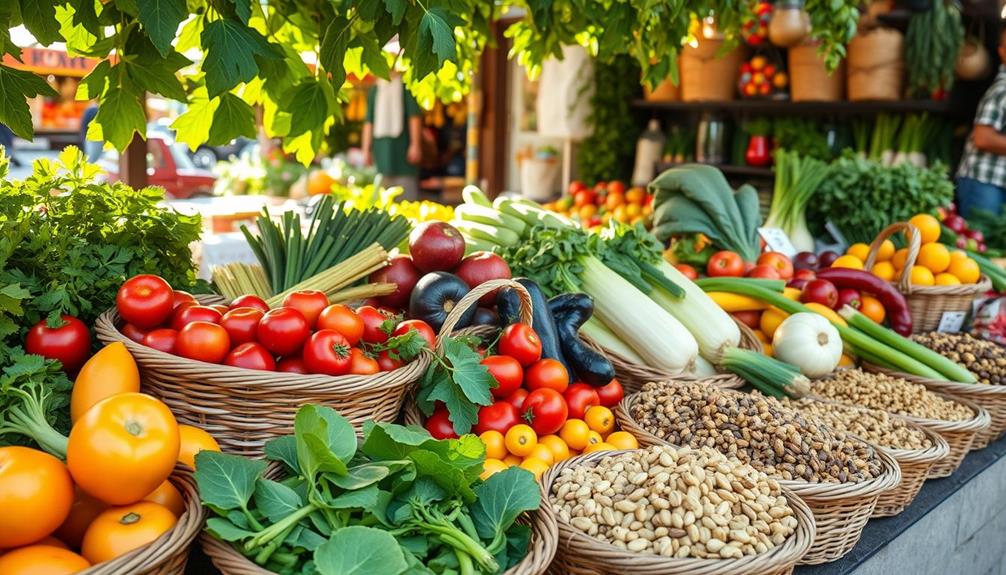
When you're shopping for raw vegan foods, prioritizing local farmers markets can lead to a bounty of fresh, organic produce that not only supports your health but also local agriculture. These markets often feature seasonal items, giving you the freshest fruits and vegetables available. Don't overlook Asian and Latin markets either, as they can offer unique tropical fruits that diversify your raw vegan meals.
Additionally, health food stores typically have dedicated sections for raw snacks, breads, and cookies, making it easier to find compliant products for your raw vegan diet. To guarantee variety and meet your nutritional needs, focus on including nuts and seeds in your shopping cart.
Here's a quick reference table to guide your shopping:
| Category | Examples | Benefits |
|---|---|---|
| Fruits | Berries, bananas, mangoes | High in vitamins and antioxidants |
| Vegetables | Kale, cucumbers, bell peppers | Nutrient-dense and hydrating |
| Snacks | Raw granola bars, nut mixes | Convenient and satisfying options |
Sample Meal Ideas
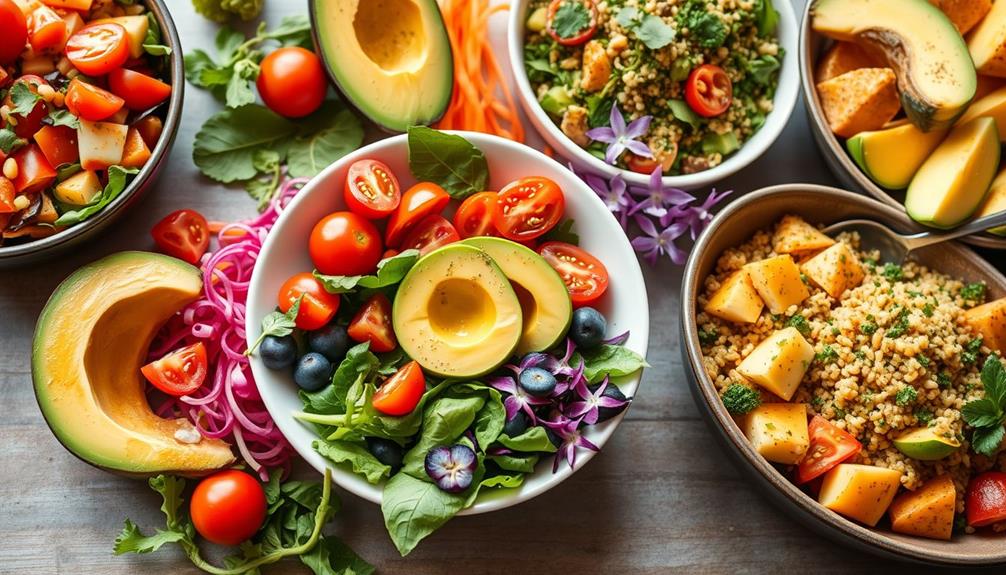
When planning your raw vegan meals, think about how you can mix flavors and textures throughout the day. Incorporating fresh fruits and vegetables not only enhances taste but also provides essential nutrients for your body.
For breakfast, you might enjoy an invigorating smoothie, while lunch could feature a vibrant salad packed with nutrients. As you consider dinner options, zucchini noodles with a raw tomato sauce can be a satisfying way to end your day.
If you're looking for healthy snack ideas, consider safe snacks for hamsters that can inspire your own healthy choices.
Breakfast Options
Starting your day with a raw vegan breakfast can be both delicious and nutritious, providing an opportunity to harness the power of imagination in your meal choices.
You'll find that these breakfast options not only satisfy your hunger but also fuel your body with essential vitamins and healthy fats. Here are three ideas to kickstart your morning:
- Chia Pudding: Soak chia seeds in almond milk, then top with fresh berries. This nutrient-dense option keeps you full and energized throughout the morning.
- Smashed Avocado on Raw Bread: Spread ripe avocado on a slice of raw bread for a creamy, satisfying meal. The healthy fats and fiber will help you stay satiated until your next meal.
- Smoothie: Blend your favorite fruits and leafy greens for a revitalizing drink. This quick option is packed with nutrition and hydrating properties, making it an excellent choice to start your day.
You can also consider overnight oats, which are raw oats soaked in nut milk, combined with fruits and nuts for added energy.
Whichever option you choose, you'll be embracing a vibrant start to your day with raw vegan goodness!
Lunch Ideas
Lunchtime can be a delightful opportunity to explore the vibrant flavors and textures of raw vegan cuisine. You can create a colorful salad using a variety of fresh vegetables, nuts, and seeds, which can also help you maintain a balanced budget plan for healthy eating. This meal not only satisfies your hunger but also provides essential vitamins and healthy fats.
For something different, try zucchini noodles topped with a raw tomato sauce made from blended fresh tomatoes, garlic, and herbs. It's a satisfying and nutritious alternative to traditional pasta.
If you're in the mood for wraps, use collard greens filled with hummus, sliced avocados, and shredded carrots. This fiber-rich meal is both filling and energizing.
Another fun option is raw vegan sushi rolls. Simply use nori sheets filled with sliced vegetables, avocado, and sprouted quinoa for a delicious, visually appealing lunch.
And don't forget about snacks! Energy balls made from blended dates, nuts, and seeds are perfect for a quick midday boost while sticking to raw vegan principles.
These lunch ideas offer you a wonderful array of flavors and textures, ensuring you stay energized and satisfied throughout the day!
Dinner Suggestions
Dinner can be an exciting time to indulge in the creativity of raw vegan cooking. You can whip up vibrant, unprocessed dishes that are packed with nutrients and flavor.
Here are three delicious meal ideas to inspire your next dinner option:
- Zucchini Noodles with Raw Tomato Sauce: Spiralize fresh zucchini and top it with a sauce made from blended tomatoes, garlic, and herbs. This meal is invigorating and rich in vitamins.
- Raw Vegan Tacos: Use crisp lettuce leaves as taco shells filled with a hearty mix of sprouted lentils, creamy avocado, and diced tomatoes, topped with a zesty lime dressing. It's a fun way to enjoy healthy fats while keeping things light.
- Hearty Salad with Cashew Dressing: Combine mixed greens, shredded carrots, and bell peppers, drizzled with a creamy dressing made from blended cashews and nutritional yeast. This salad is both filling and flavorful.
Don't forget dessert! A simple chia pudding made from soaked chia seeds in almond milk, topped with fresh berries and raw agave syrup, rounds out your raw vegan dinner perfectly.
Frequently Asked Questions
What Foods Are Not Allowed on a Raw Vegan Diet?
On a raw vegan diet, you can't have any animal products, cooked foods, processed snacks, alcohol, refined sugars, or anything that's been pasteurized or homogenized. Stick to fresh, uncooked fruits, vegetables, nuts, and seeds.
What Are the Rules for Raw Veganism?
Did you know that over 70% of raw vegans report increased energy levels? To follow raw veganism, you'll eat unprocessed plant foods, avoid heating above 118°F, and exclude all animal products and processed items.
What Is the Raw Food Theory?
The raw food theory claims cooking destroys essential nutrients and enzymes. You believe consuming unprocessed, plant-based foods enhances digestion and energy while reducing chronic disease risks. Preparation methods like blending and sprouting help maintain nutrient integrity.
What Is the Raw Food Diet Full Explanation?
Did you know that over 75% of raw foodists report increased energy levels? The raw food diet emphasizes unprocessed, plant-based foods, promoting health by preserving essential nutrients, while often requiring careful planning to avoid nutritional deficiencies.
Conclusion
Embracing a raw food vegan lifestyle can be like opening a vibrant garden of health and vitality in your life. By focusing on fresh, uncooked fruits, vegetables, nuts, and seeds, you'll nourish your body with essential nutrients while enjoying a myriad of flavors. However, it's essential to stay mindful of nutritional balance and potential risks. With the right knowledge and preparation, you can thrive on this exciting journey toward better health and well-being. Immerse yourself and explore!



